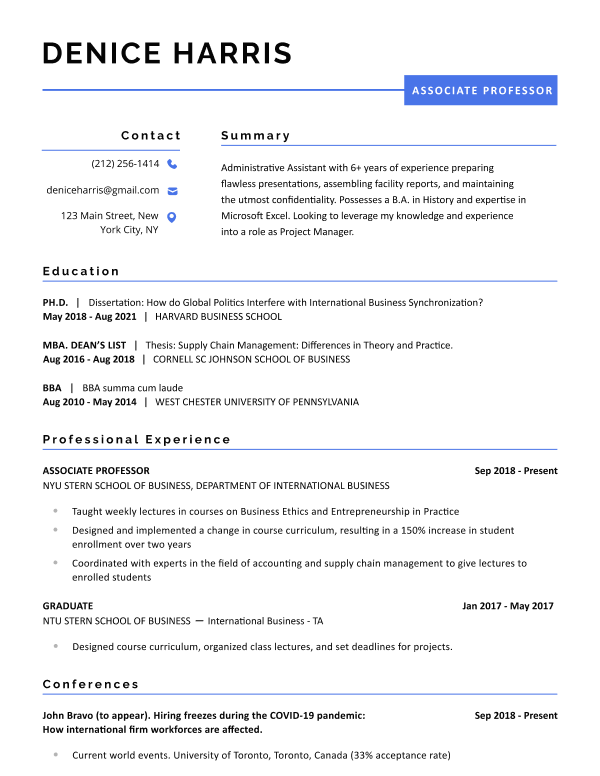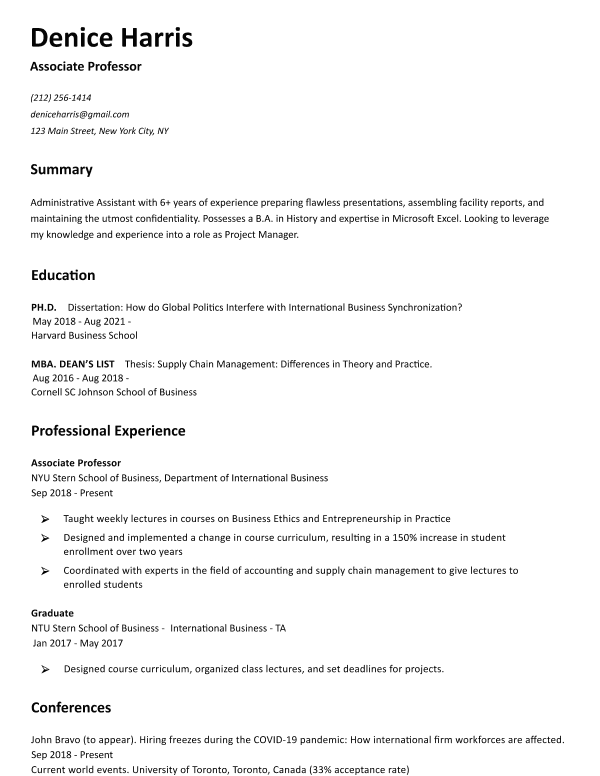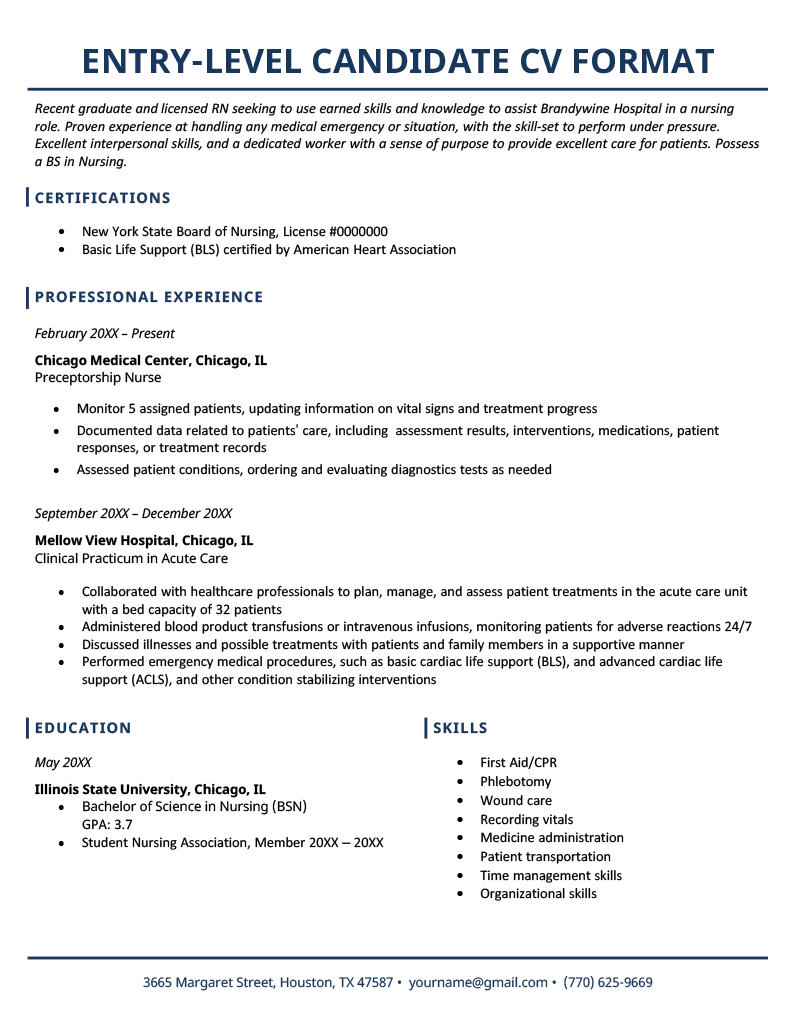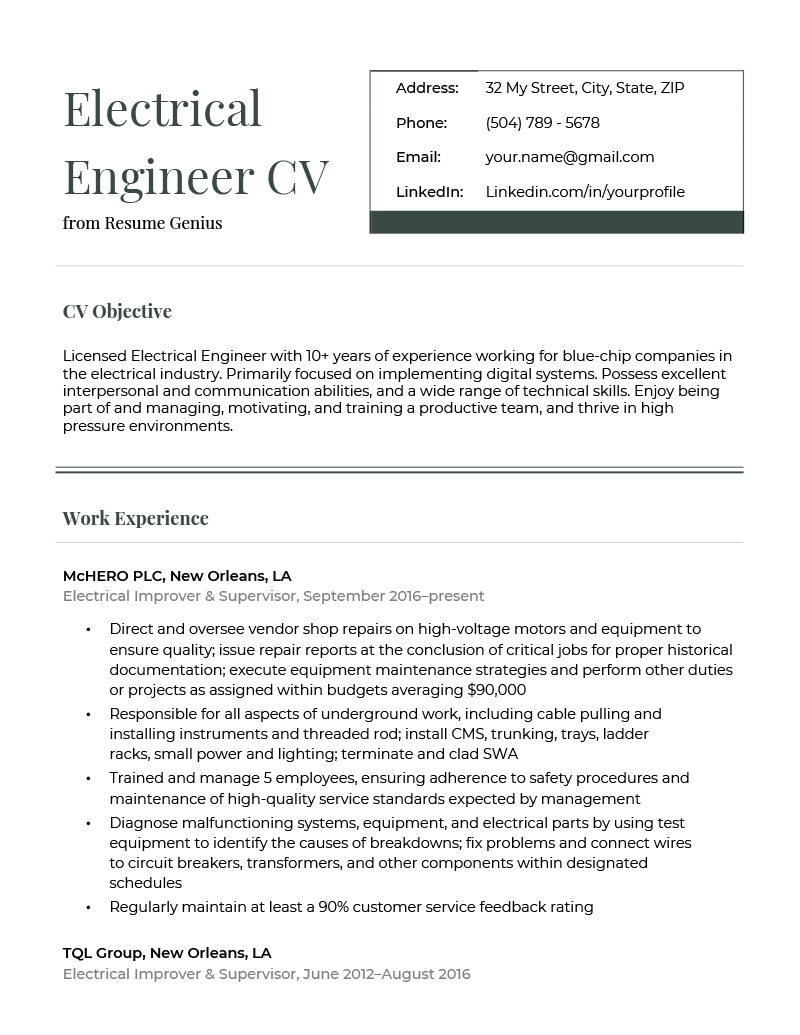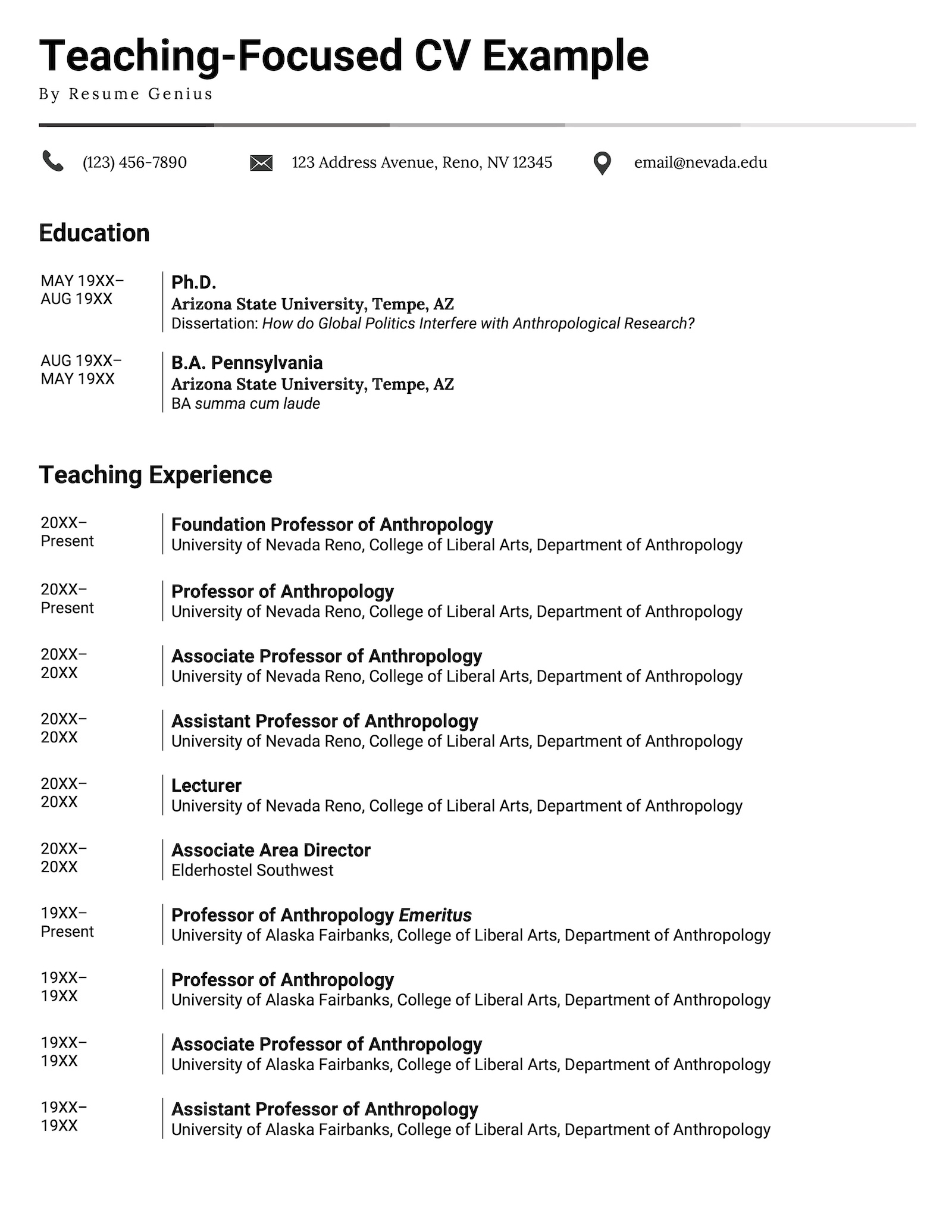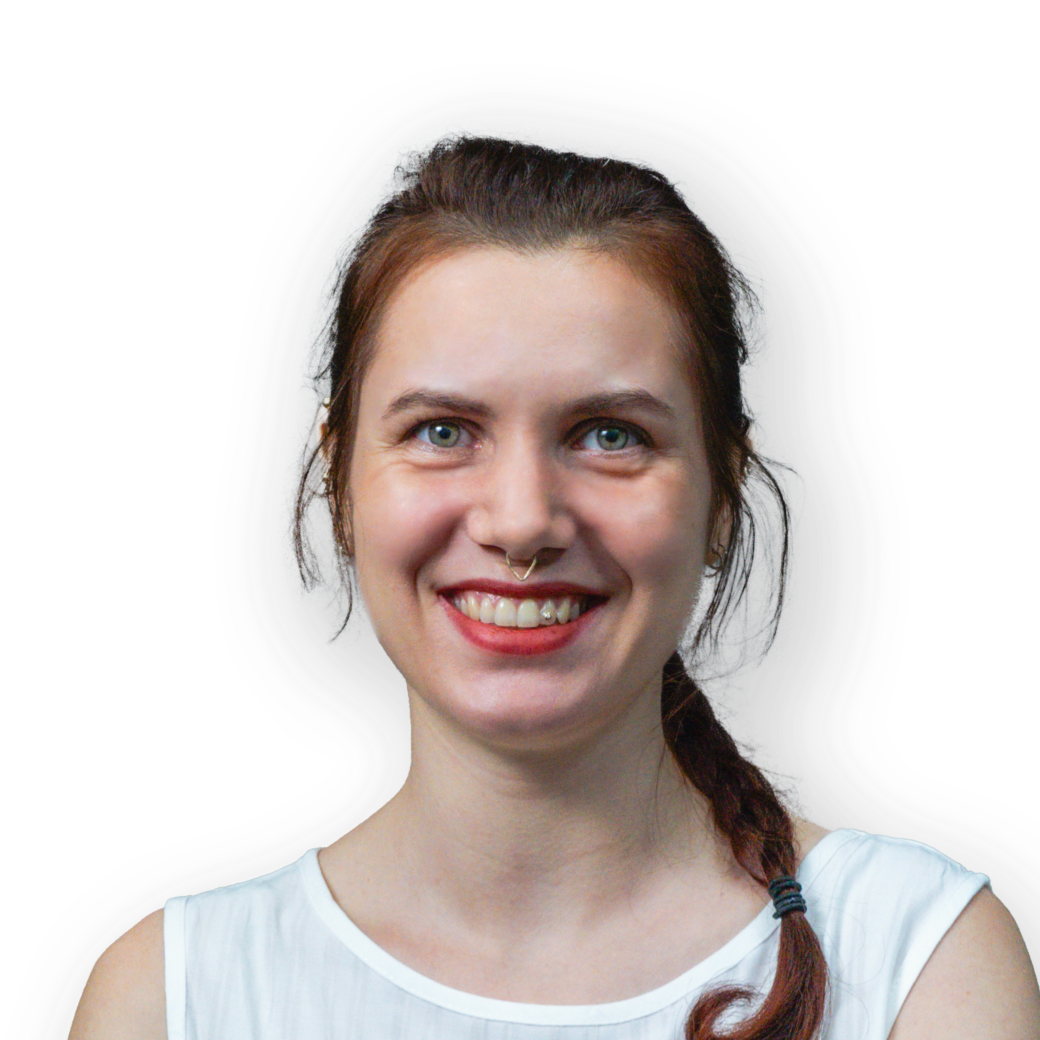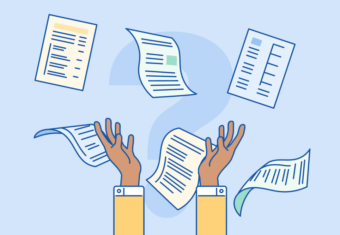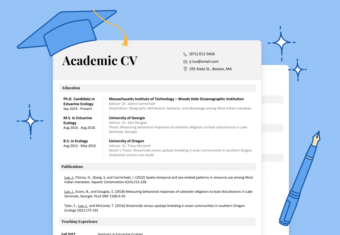Before you start writing a CV, you need to know how to properly format each section. In this article, we’ll show you what to include in your CV, how to properly format it, and give you several CV examples and CV templates to draw inspiration from.
Our free-to-use cv builder can make you a cv in as little as 5 minutes. Just pick the template you want, and our software will format everything for you.
The best format for a CV is the chronological format (also called reverse-chronological). When using this format, you’d list your job history or relevant experience starting with your most recently-held position at the top.
To help you navigate formatting your CV, we’ll break down the essential sections you need to include, plus some optional sections that may help you present your qualifications. Here are the sections you should include in your CV:
1. Header
Your CV’s header should include the following contact details:
- Your name: format your name in bold text and set it in a larger font size than the rest of the text on your CV. Making your name stand out helps the hiring manager notice your application and then easily find it again.
- Your mailing address: you can also choose to simply include your city and state.
- Your contact information: be sure to use a professional email address. If you wish you can also include your phone number.
- Online profiles: add links to relevant online profiles (such as LinkedIn) or portfolios to highlight your work.
Here’s an example showing how to format your CV header:
Henrietta Williams
Associate Professor of Philosophy
h.williams@harvard.edu
69 Hillside Street, Boston, MA 02120
2. CV summary or personal statement
Just like a resume introduction, your CV should begin with a summary of your most important achievements and your professional goals. Think of this section as a way to introduce yourself to the hiring manager and get them curious about the contents of your CV.
Here’s an example of a great CV personal statement:
PERSONAL STATEMENT
Nurse RN with 6+ years of experience providing quality care to a wide variety of patients. Possesses a Master’s qualification in nursing and currently focused on earning a Doctorate Degree in this field. Aiming to leverage my experience and knowledge to effectively fill the nursing position at your hospital.
If you’re working on an extensive academic CV, you can skip this section and use the other CV sections to highlight your achievements.
3. Education
Format your CV’s education section by listing all your degrees, following this format:
EDUCATION
UNIVERSITY OF MARYLAND, SCHOOL OF PHARMACY, College Park, MD
May 2019
Master of Science in Pharmaceutical Sciences
Your education section should always include your:
- Institution name
- Institution location
- Graduation date
- Degree title
Optionally, you can also include your GPA and honors if you’re applying to graduate school or are especially proud of your achievements.
4. Professional experience
Start each heading in your work experience section with the name of the institution or company, followed by your job title and employment dates.
Under each heading, list your most relevant accomplishments — supporting them with hard numbers when possible — in a few bullet points.
Here’s what a work experience section looks like when you use professional CV formatting:
PROFESSIONAL EXPERIENCE
Registered Nurse, Dec 2020-Present
Virginia Veteran’s Hospital, Richmond, VA
- Provide direct quality care to patients including daily monitoring, recording, and evaluating of medical conditions of up to 20 patients per day
- Coordinate workforce management objectives with a focus on individual, departmental, and hospital-wide initiatives
- Lead and mentor 10 newly licensed nurses in developing and achieving professional expertise
5. Relevant skills
Use the skills section of your CV to highlight specific skills that are relevant to the position you’re applying for.
Here’s an example of how to format your skills on a CV:
ADDITIONAL SKILLS
- Data collection
- Literature review
- Research study design
- Statistical analysis
- Project management
It’s a good idea to emphasize hard skills (like experience with certain software or technical skills) in this section, particularly if they’re listed in the job description.
6. Optional CV sections
If you’re making an academic CV or have many years of relevant job experience, there are other optional CV sections you can consider adding to your CV.
Additional CV sections include:
- Teaching experience
- Research
- Publications
- Grants & fellowships
- Presentations
- Conferences
- Honors & awards
- Certifications & licensure
- Professional associations
- References
While that’s a lot of sections, keep in mind that they can be combined to make your CV more concise. For example, if you’ve only given one presentation and attended one conference, list them both under a “Presentations & Conferences” section.
Alternatively, if you have an extensive list of publications or research projects to include under a single section, you can split them into subcategories. For instance, publications can be divided under subheadings like books, articles, academic journals, etc.
For more tips and advice on putting together your academic CV, check out this video:
Don’t forget to include a cover letter to accompany your CV. Learn what the differences are between a CV vs a cover letter so you can better showcase your transferable skills, character traits, and reasons for applying to a company.
CV format samples for different types of job seekers
To make sure your CV follows proper formatting, use any of the templates below to get started and adjust the content to fit your situation.
CV format sample for an entry-level candidate
When writing a CV for an entry-level position, you should be able to fit all your experience on one or two pages. Here’s a good example:
CV format sample for an experienced candidate
As an experienced candidate, you may have enough relevant job experience to make a two-page CV. See how this electrical engineer formats their 10+ years of experience on a CV for a job.
Academic CV format sample (teaching-focused)
If you’re applying to a university teaching position, you should use academic curriculum vitae formatting and highlight your teaching experience by listing it on the first page.
Here’s an example of a teaching-focused academic CV:
The sample is adapted from the original 24-page CV of Dr. G. Richard Scott, a Professor of Physical Anthropology at the University of Nevada with nearly five decades of experience. (Contact information and other details have been changed.)Academic CV format sample (research-focused)
Are you applying to a research position at a university or a lab? Use academic CV formatting, but begin listing your research experience on the first page.
This sample rearranges Dr. Scott’s information to emphasize his research experience. Follow this CV example to apply for an academic or scientific position:
If you’re applying to a European company, write a Europass CV to showcase your qualifications in a format common in Europe.
Click to rate this article
4.8 Average rating



